
|
|
 |
||||||||||||||||||||
|
|
|||||||||||||||||||||
|
RAPTORS REIGN Along the “Castle Roads” of Germany and France, Raptors Still Rule Text and Photos by Skip Kaltenheuser and Erin Caslavka GERMANY What is today referred to as the ‘Castle Road’ teaches how tough life could be amidst the serendipity of war and plague. Plagues often followed on the heels of bloody conflict, killing up to 90% of villagers and creating instant land redistribution that kept some from migrating. The Thirty Years’ War was just one of many nasty periods that left folks rolling the dice to decide which side was least likely to slaughter them. It’s startling to realize that despite the slip and slide and madness of the last century, Germany (at half the size of Montana) still possesses one of the world’s largest economies. 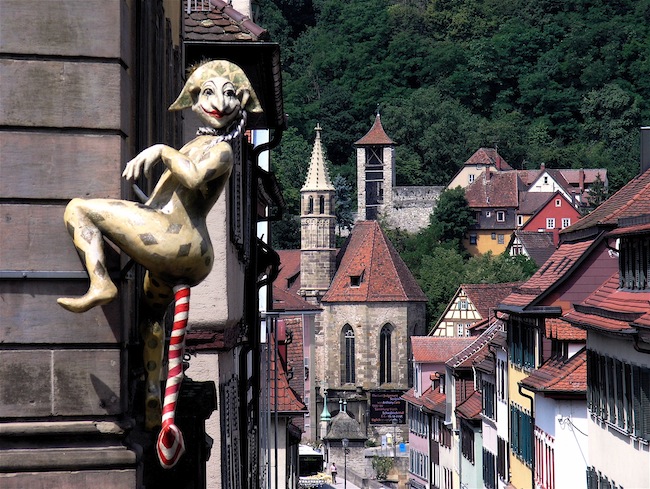 German tourism might best be described as “awe for the surviving architecture of past centuries” - some all the way back to Roman-Germanicus times. The villages that remain intact are both charming and frightful, in reference to the historical slings and arrows that populations in this region suffered over the centuries. German tourism might best be described as “awe for the surviving architecture of past centuries” - some all the way back to Roman-Germanicus times. The villages that remain intact are both charming and frightful, in reference to the historical slings and arrows that populations in this region suffered over the centuries. Among the most enticing of these is the walled village of Bad Wimpfen, with its red-roofed chalet style houses punctuated with colored timbers. Another favorite is Schwabisch Hall, on hills overlooking the Kocher River. The medieval town, originally supported by mining salt, now sports a replica of the Globe Theater, free outdoor performances in the town square, a grand art museum, and ample jazz in local taverns. Outdoor art is plentiful. While we were there, a huge exhibit of Henry Moore sculptures were strewn throughout this medieval town. The region around Neckarzimmern Village has some of the country’s best castle offerings, including the vineyards and ruins of Castle Hornberg, where the famed knight Gotz was treated to a 12 years under house arrest for championing peasant causes. Now it boasts one of the top restaurants in the valley, and a hotel with rooms opening into the forest is built into the old stables. It’s been a possession of the Barons of Gemmingen for a dozen generations. Across the river stands a fully intact castle, owned by another Gemmingen Baron whose kids (the 19th generation there) have the run of the castle, and of the torture chamber that fascinated my daughter, Katie. His castle, Burg Guttenberg, hosts a terrific falconry 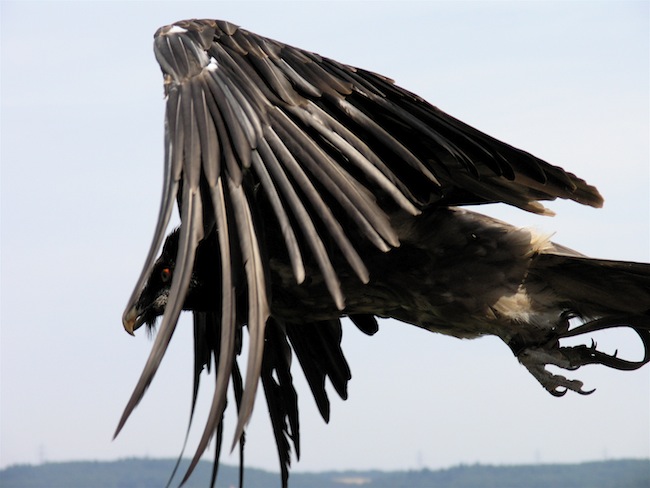 show for children, run by falconers Claus and Bettina Fentzloff, who have pioneered raptor preservation efforts around the world. Up close and personal, the eagles, vultures, owls and falcons soar from the show out over the valley. show for children, run by falconers Claus and Bettina Fentzloff, who have pioneered raptor preservation efforts around the world. Up close and personal, the eagles, vultures, owls and falcons soar from the show out over the valley. 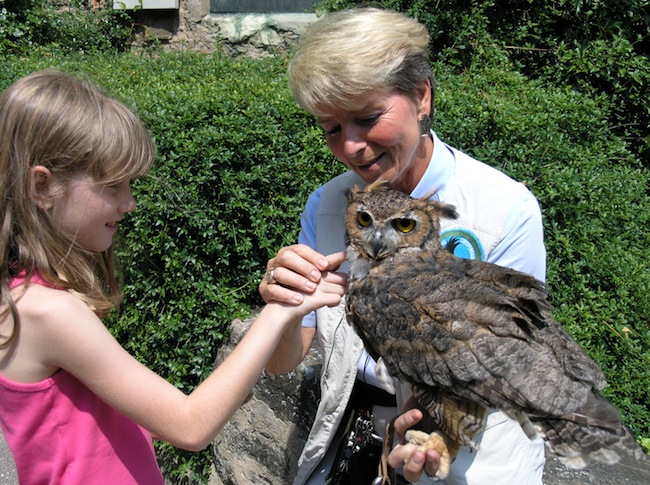 I rose from my seat to photograph an eagle and was instantly beaned by the bird, who knocked off my hat and almost took my camera. I rose from my seat to photograph an eagle and was instantly beaned by the bird, who knocked off my hat and almost took my camera.I asked the Baron his family’s secret for keeping a castle whole during half a millennium of rugged history. “Negotiation,” he replied without a hint of sarcasm. Which is probably how the area’s raptors have survived for as long as they have. Just like the German patriarch and his family, they’re still perching inside of baronial estates - flying high under the sun-soaked skies. 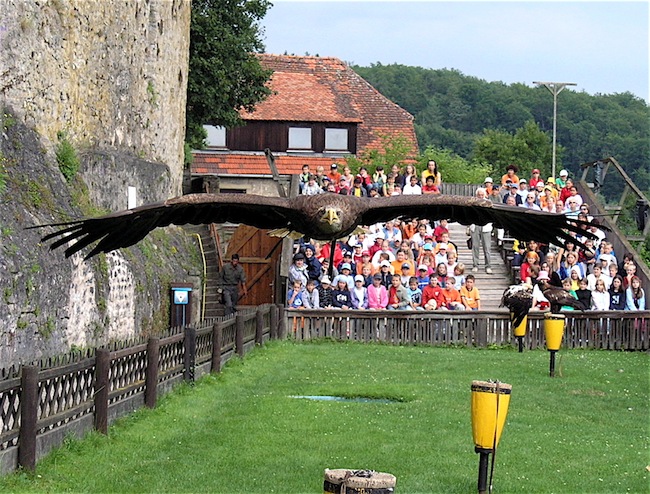 FRANCE Taking a bit of advice from a girlfriend who'd recently toured France with her husband, my significant other and I left Paris on a brilliant sunny day and boarded the high-speed train for Strasbourg, in the Alsace region.  We arrived at the station and promptly hired a rental car, after learning that the best way to explore the famous "Wine Route" would be on our own terms - both for scheduling purposes, as well as for accommodating unexpected moments of serendipity. We arrived at the station and promptly hired a rental car, after learning that the best way to explore the famous "Wine Route" would be on our own terms - both for scheduling purposes, as well as for accommodating unexpected moments of serendipity.The Alsace region is a narrow, 130-mile long strip of land lying between the Vosges Mountains and the Rhine River. Here, the influence of nearby Germany is obvious, from the hearty fare served in local restaurants to the storybook architecture of its buildings. And the names of the villages - Molsheim, Rosenwiller, Reichsfeld, to name but a few - underscore that Germanic influence. Luckily for me, the wines produced in the area are of the sweeter variety; in particular, gewurztraminer and riesling. Stepping into a local winstub (or wine bar), we were even able to locate a fabulous organic riesling, which we savored along with some locally-made cheeses and freshly-baked bread at a patio table overlooking the town square of the charming town of Equisheim. Noted as  “a cradle of Alsace viticulture at the foot of three castles,” the medieval city was also the birthplace of Pope S. Leo IX in 1002. As if that’s not enough history for you, the village also lays claim to a Romanesque church with a 13th-century belfry, and the remains of an octagonal Roman castle from 780 AD. “a cradle of Alsace viticulture at the foot of three castles,” the medieval city was also the birthplace of Pope S. Leo IX in 1002. As if that’s not enough history for you, the village also lays claim to a Romanesque church with a 13th-century belfry, and the remains of an octagonal Roman castle from 780 AD. We left the charming enclave of Eguisheim and headed for one of the most prominent castles in the region: Chateau du Haut-Koenigsbourg. Located at the top of a mountain, the castle overlooks numerous villages and offers up a spectacular panoramic view of the verdant countryside. A brochure from the castle’s admission desk states that “from the Grand Bastion, you can see the Alsace plain, the Vosges, the Black Forest and on 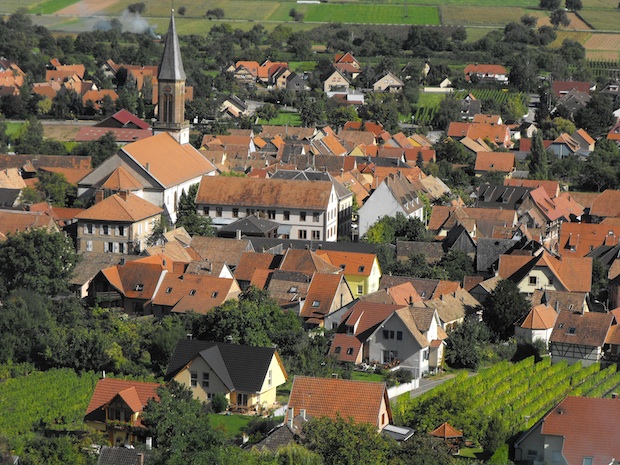 a clear day, the Alps...” a clear day, the Alps...”It was a pretty clear day when we arrived, but we weren’t equipped with high-power binoculars so we settled for the view visible with the naked eye. At the base of the mountain we spied villages with neat rows of grapevines, tidy homes with red-timbered roofs and church towers that rose up out of the mist. All-in-all, it was a rather princely view. Koenigsbourg Castle didn’t disappoint, either. Built in the 12th century, the castle withstood the passage of time (and the comings-and-goings of a variety of monarchs), until it was eventually restored to its original elegance in 1908.  Guided audio tours brought the castle’s history back to life, as we marveled at the craftsmanship inside the rooms. On the ceiling of the Kaiser room, an imperial eagle and coats of arms provided a visual picture of the families who dominated the area. The luxurious bedroom furnishings (and the arms and armor on display), attested to the wealth of the various barons and princes who called the castle home. Guided audio tours brought the castle’s history back to life, as we marveled at the craftsmanship inside the rooms. On the ceiling of the Kaiser room, an imperial eagle and coats of arms provided a visual picture of the families who dominated the area. The luxurious bedroom furnishings (and the arms and armor on display), attested to the wealth of the various barons and princes who called the castle home.At the conclusion of our tour, I happened upon a brochure for another nearby castle: the Chateau de Kintzheim. But what attracted me wasn’t so much the chance to explore another set of stone ruins; instead, I was captivated by the image of a bald eagle soaring above the castle. So off we set in search of La Volerie des Aigles - the “Eagle Aviary.” Since 1968, a raptor show has been held at the base of Kintzheim castle. The first of its kind in France, it provides an educational and entertaining introduction to the largest birds of prey in the world. Kept on the grounds (but free to fly wherever, and whenever, they choose) the birds range from the beautiful (the owl, hawk and eagle) to the ugly (the vulture and condor). The show began with a flying demo courtesy of the black kite, who caught pieces of meat in mid-air using its claws instead of its beak. An American bald eagle came next, impressing everyone in attendance with its aerial prowess and regal bearing. An imperial eagle and an African sea eagle were also on display, showing off their particular flying techniques.  One of the fun parts of the show came when the trainer instructed everyone to sit on the ground. (Although the show was delivered entirely in French, we could figure out what was happening when everyone suddenly got up from the benches and sat down on the gravel instead.) As the trainer led the vulture around the arena - enticed by a piece of meat he held in his gloved hand - we could feel the strength of its talons as it walked over our legs, 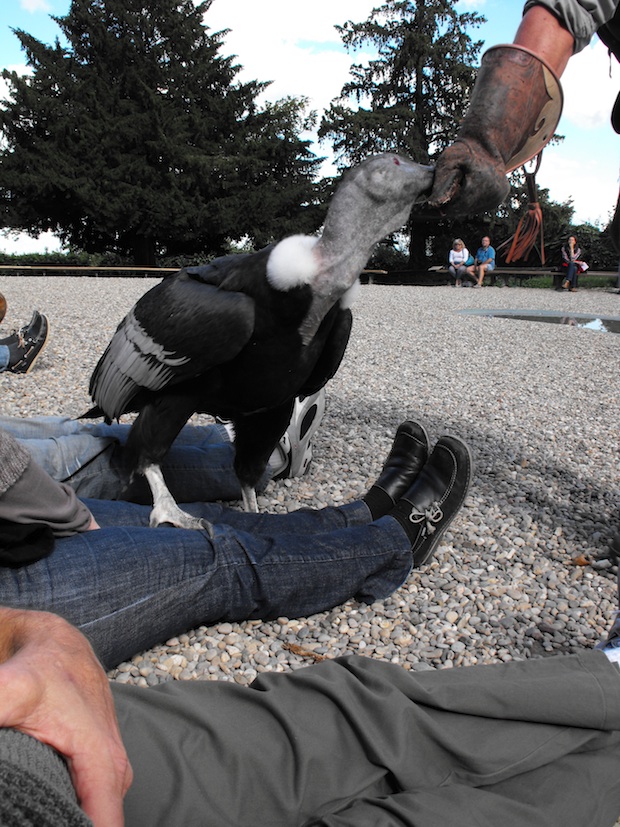 balancing itself atop our thighs. balancing itself atop our thighs.The birds that probably impressed us the most were the owls. Never really thought of as being “majestic,” I could definitely see how they’ve come to be regarded as “magical.” It’s no wonder that uber-wizard Harry Potter selected an owl as his animal companion. Powerful, gorgeous, capable of incredible feats of prowess, silent and stealthy, and able to view the world around them almost in 360-degrees - who wouldn’t want those attributes? Which got me to thinking about the rulers of the castle whose ruins we sat beneath. Hundreds of years ago, birds of prey were flying the skies above Alsace. 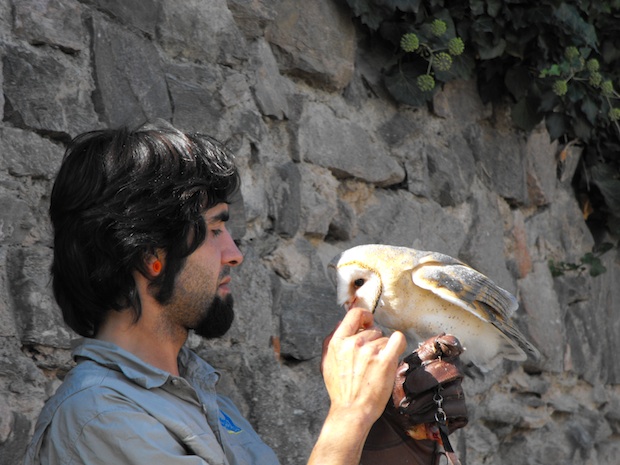 While some things may have changed, the birds are still there. FAST FACTS Claus and Bettina Fentzloff www.claus-fentzloff.de French Tourist Office www.francetourism.com La Volerie des Aigles (Eagles' Aviary) Chateau de Kintzheim www.voleriedesaigles.com Chateau du Haut-Koenigsbourg (in Orschwiller) www.haut-koenigsbourg.fr |
|
|
|
|
| Site Map |